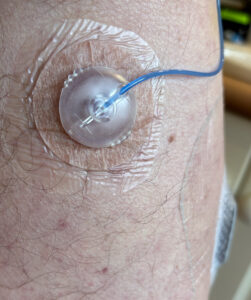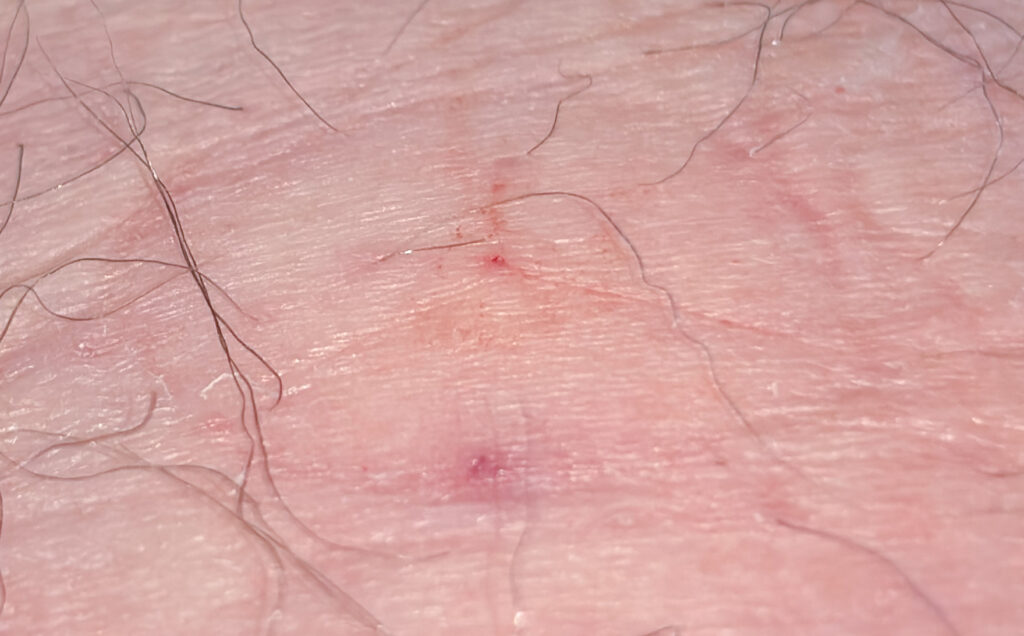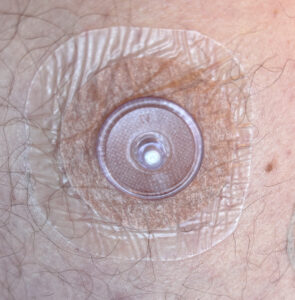There’s one major annoyance for me with the Orbit infusion sets, but I may have found a workaround.
I’ve written in the past about the Orbit sites that these days are used on the YpsoPump. One of the things I commented on back in 2019 was the “nipple marks” I would notice after removing a site. These happened with the Orbit Micro, the Orbit Soft, and even with the Orbit Micro 2.0.
My issue
Here’s an example. This is after removing an Orbit Micro after a bit over 2 days in my skin. The flesh seems to be inflamed and has expanded up into the underside of the Orbit’s mounting disk.
Here you can see the cavity around the needle (which here has been bent to one side for safety). It may be my skin reacting to that clear plastic disk.

The underside of the Orbit Soft sites is essentially identical. But I’m much more likely to encounter the issue there, presumably because the site is usually in for an extra day. Actually, I have for years tried to limit Orbit Soft sites to 2.5 days each because of this.
Orbit turn-offs
The longer the sites are in, the more likely I am to see these marks. They will usually fade within a few days, but often there’s some residual mark weeks or even sometimes months later!
In the knowledge that I’ll be using a pump for years/decades to come, and wanting to preserve the health of my flesh and infusing sites for that future success, this makes me uncomfortable. Combined with the high profile of the connecting dome and the two-handed operation usually needed in order to be confident the dome will not become disconnected later (two “clicks” are needed to be sure it’s on securely), this has meant the Orbit sites are not my first choice.
Luckily for me the YpsoPump Inset sites are available, and these are very reliable. Actually I started using the Inset II with the Animas 2020 pump back in 2009, and once I got my insertion technique sorted they have been very reliable for me across Animas, Accu-Chek, Tandem, Medtronic, YpsoPump, and even DANA pumps. Unomedical (a division of Convatec) makes the same sites for each of these.
I do try to check out all the choices along the way, so I’ve never been “exclusively-Inset”. Recently I got hold of some more Orbit Micro sites, so decided to look into a workaround. All the photos in this article are from the last week.
Protecting the skin
Taking a cue from the common Flexifix technique for stabilising Omnipods and letting them last their full 3 days, I decided to try the same. Essentially we fire the cannula through the dressing, protecting the skin from touching the Orbit plastic.
Installing an Orbit site gained a few extra steps (and this description would apply for both Soft and Micro versions):
- I cut out a small piece of Opsite Flexifix dressing, just a little larger than the Orbit adhesive.
- Disinfect the site.
- Adhere the dressing to the skin. I always stretch the skin slightly while it’s being applied. This means that when the skin relaxes the dressing will wrinkle a bit, and avoids the dressing pulling across the skin and irritating it around the edges when the skin stretches during normal movement.
- Warm the dressing by holding the palm of my hand on it for a few minutes, to fully activate the adhesive.
- Remove the green cover-layer if not already removed, and give the tape a quick wipe with alcohol just to be sure it’s clean on top.
- Insert the Orbit site through the centre of the dressing.
- Run a fingertip around the Orbit adhesive to press it down, and then remove the clear “insertion-dome”.
- Again, hold my palm on the site for a few more minutes, to make sure the layers have bonded together fully in the warmth.
By the way, that’s on a slightly hairy leg. I was curious to see how the removal would feel afterwards…
This is off-label!
Obviously this is not covered in the manufacturer’s approved instructions, so it’s quite off-label. Some people do this with other dressings such as Tegaderm or Fixomull Transparent, but the description above is based on the Opsite Flexifix.
I’m always careful to be sure my sites are clean before I insert a cannula, as I have a high respect for nasty germs like the Staphylococcus family. I did decide that the Orbit Micro sites (a thin and sharp 33G needle) and the Orbit Soft (a sharp 27G needle surrounded by a teflon cannula) are inserted fast enough that there’s little chance of them taking materials such as plastic into the skin, but obviously I haven’t done a deep study on the microscopic effects.
This experiment
 I used 3 Orbit Micro sites in a row. The middle one was inserted without an Opsite Flexifix layer as per normal. You saw the resulting mark on my skin afterwards at the top of this post.
I used 3 Orbit Micro sites in a row. The middle one was inserted without an Opsite Flexifix layer as per normal. You saw the resulting mark on my skin afterwards at the top of this post.
The other two were protected with Opsite.

The first two sites were on my abdomen. The last one (shown here) was on my leg.
The result
When the protected sites were removed, as usual there was a tiny red mark where the cannula had been piercing the skin. This soon fades of course. But there was no inflammation or lump/”nipple” around it. I count this as a successful experiment!
The last photo is of the hairy leg after removal. The hair wasn’t pulled up with it. I worked at the Opsite edge with a fingernail until it started lifting and there was enough to get a solid hold of, then pulled off the entire site in one quick motion (pulling across the site, not “up” per se). It didn’t hurt. I do of course make sure I’m going to pulling the site in the same direction that the hairs are generally lying in.

Here you can see faint circular impression left by the plastic Orbit disk, and two red marks. The centre one is where the needle had been. That will fade quickly. The one towards the lower edge is actually a mark from an earlier Orbit experiment over a month prior!
If I find myself faced with using Orbit sites again (e.g. if there was a shortage of Insets) I’m now happier than I had been when considering that prospect.


Great post David. I definitely have similar issues and it is a worry about the long term damage Orbit micros can do to the skin. I’ve stopped using the Orbit Micro 2 as I find the adhesive is too aggressive to remove and even with a remove wipe the adhesive leaves my skin inflamed and itchy. I’ll be trying your techniques. Thank you.
One thing I have to be careful about with all infusion sets and CGMs is to not remove them when my skin is warm and wet after a shower. It’s much more susceptible to being inflamed. So I either remove before a shower, or wait a few hours afterwards. Then when remove it roll it quickly across rather than pulling up.
Because I leave my previous infusion site in for a few hours after placing a new one (lets the previous doses be absorbed fully, plus provides a backup if the new site is a dud) I can still put on a new one soon after a shower, as I won’t be removing the old one for a couple of hours anyway.